[ad_1]
In honor of Women’s History Month, the Los Angeles Times photography department would like to highlight our award-winning female staff photographers.
Francine Orr joined the Times photography staff in 2000. Previously she had been a photographer for the Kansas City Star. Raised in Colorado, she earned a bachelor’s degree in both history and art from the University of Saint Mary. Orr also joined the Peace Corps and was a volunteer in Yap, Federated States of Micronesia. While there, she learned how to be a quiet observer and gained a love for stories.
Orr’s photographic focus has been on public health and poverty issues in Africa, India, and the United States. In Los Angeles, she has concentrated on the growing homelessness crisis as well as the COVID-19 pandemic.
A few of Orr’s honors include the 2020 Meyer “Mike” Berger Award for outstanding in-depth, human interest reporting from Columbia Journalism School, a Pulitzer Prize finalist in feature photography in 2012, a Casey Medal for Meritorious Journalism, and sharing in an Emmy Award for informational series.
As a photographer, I am able to cross perceived barriers with my camera, whether economic, ethnic, religious, or cultural by simply being present and curious
Francine Orr
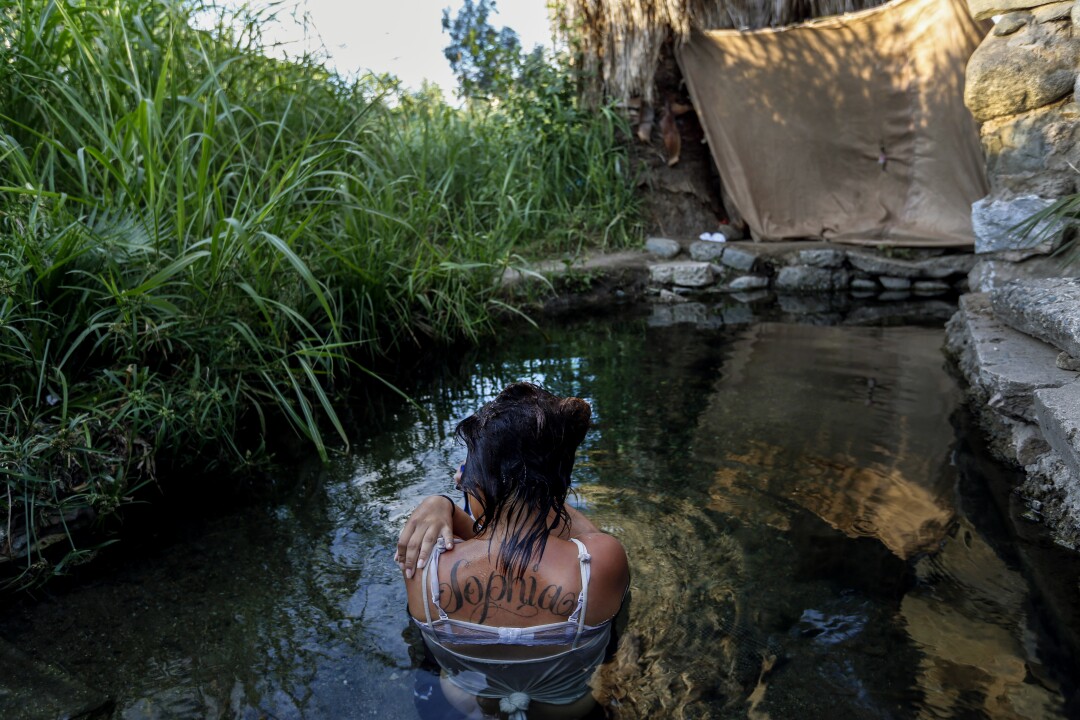
Tiny fish nibble on Deanna Ortega, 20, as she soaks in the water in Meadowbrook Park in San Bernardino. She has been staying with Rick Burns, a homeless man, in a tent next to the warm water. Sitting in the water, she washes her hair repeatedly, shaves, and occasionally smokes methamphetamine.
(Francine Orr / Los Angeles Times)
Behind the photograph:
Through photographing this assignment I learned that homeless people living around the park bathed and did their laundry in the warm water.
Each day is an opportunity to learn and overcome obstacles. It’s a gift, really, to share people’s stories.
Francine Orr
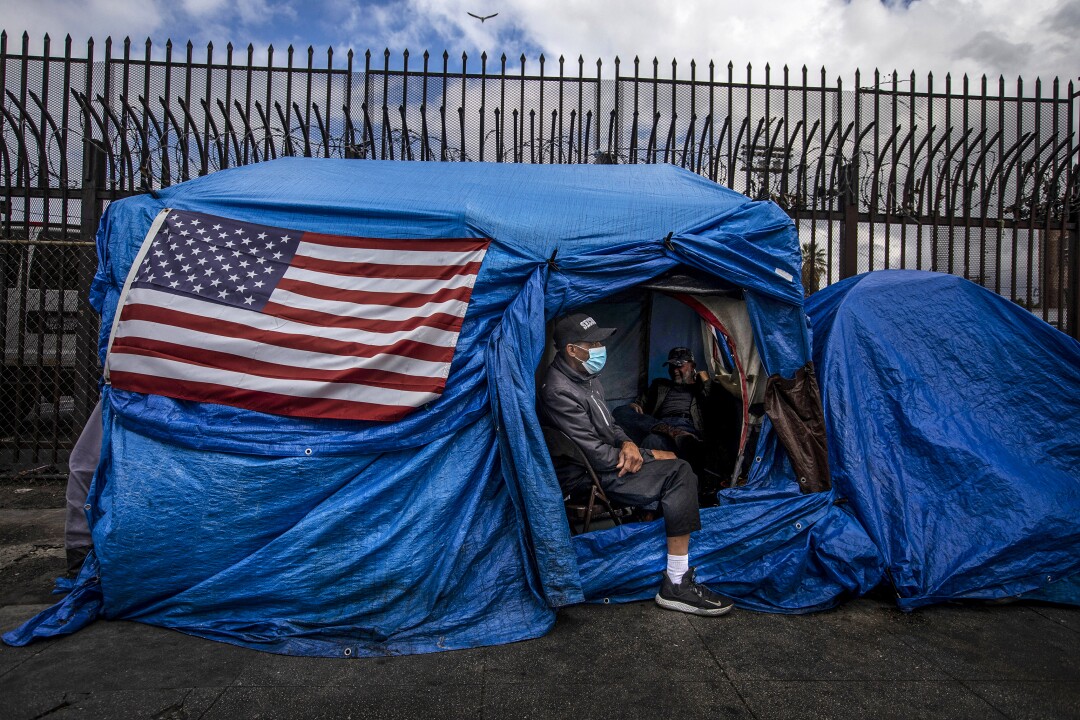
David Barker, 56, visits with a friend living in a tent on skid row in Los Angeles in March 2020. Barker is not homeless, but he works in the area. Because of the pandemic, city and county workers are working to move people living on the street inside.
(Francine Orr / Los Angeles Times)
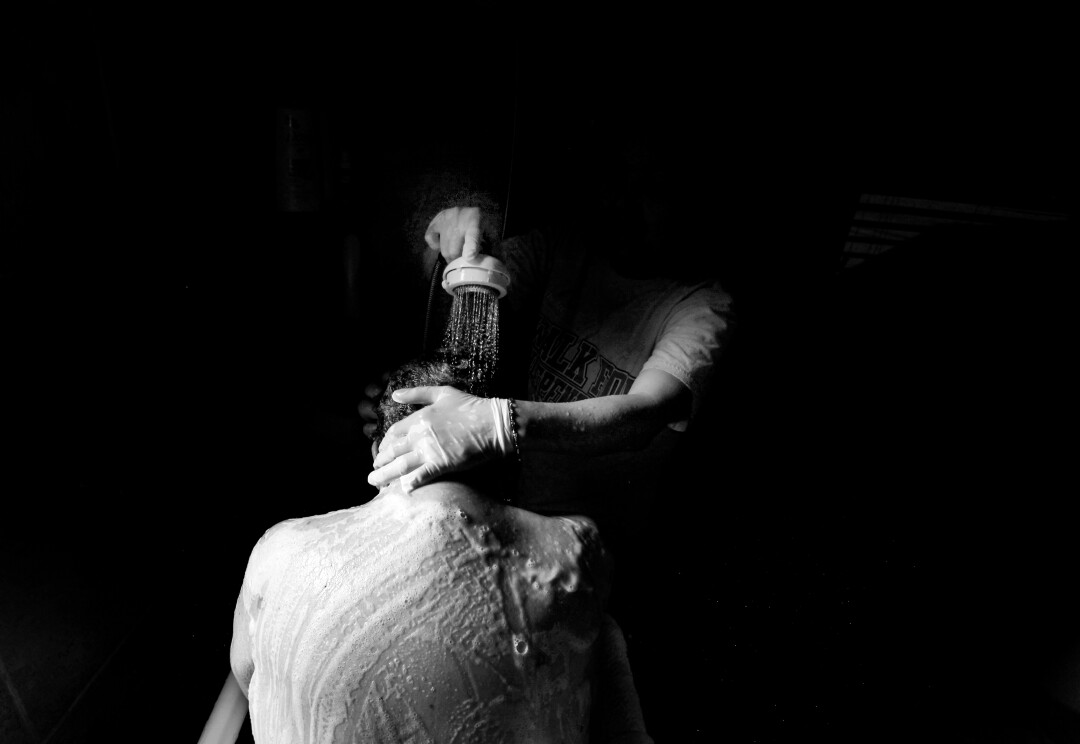
Evelyn Corsini, 83, is bathed by caregiver Didi Salcedo, 54, at Evelyn’s home, in La Verne. Corsini requires 24-hour case after a stroke and craniotomy due to a brain tumor. Salcedo has worked as Evelyn’s primary caregiver for six years.
(Francine Orr / Los Angeles Times)
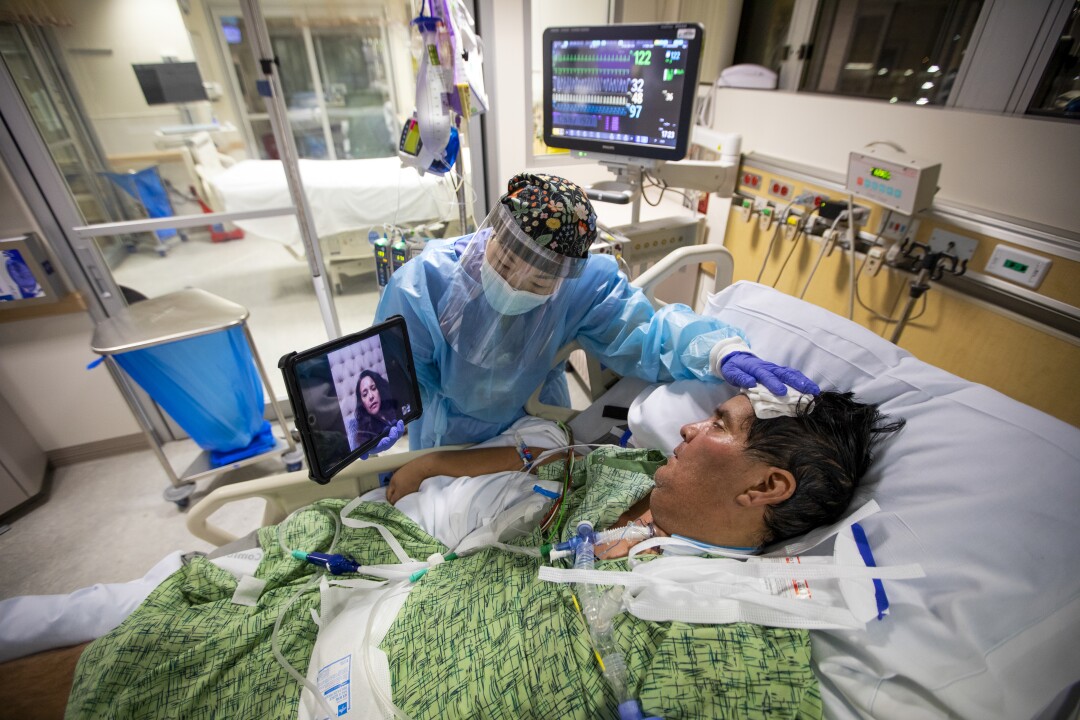
Registered Nurse Kat Yi holds an iPad up to COVID-19 patient Eduardo Rojas so he can talk to his wife, Angelica Rojas, while he is treated in the intensive care unit at Providence St. Jude Medical Center in Fullerton on Dec. 25, 2020.
(Francine Orr / Los Angeles Times)
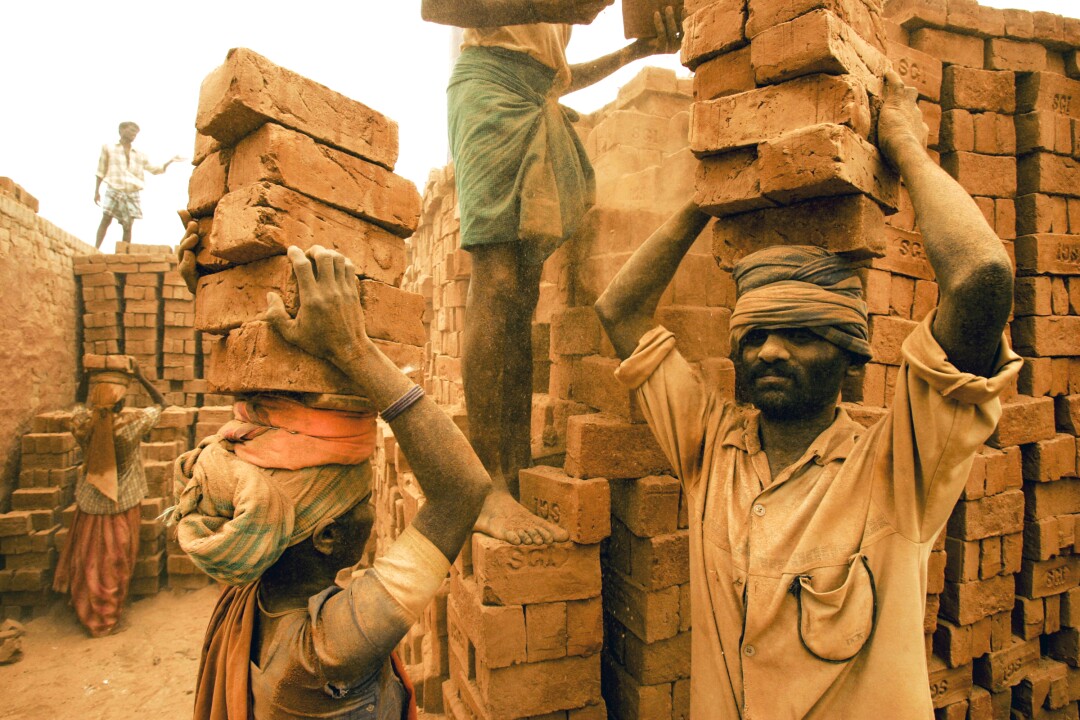
Migrant workers at a giant kiln in Red Hills, just outside of Chennai, India, pile 20 bricks at a time on their heads, as dust falls in their faces. With an unchecked spread of the HIV and AIDS epidemic in India, the country’s achievements in terms of economic growth in the next 10 to 15 years will be noticeably less than its potential, according to a study by the UNDP.
(Francine Orr / Los Angeles Times)
Behind the photograph:
The day I took this photograph, I climbed to the top of the kiln to get a higher vantage point not realizing the kiln was firing.
I was so excited to document the workers at the brick kiln that I quickly rushed past my translator. The workers began yelling as I had not realized the danger I was in.
Francine Orr
The workers carefully coaxed me down. As I safely made it to the ground, I went around the corner of the giant kiln and found workers carrying loads of bricks, sometimes 20 at a time, on their heads as red dust fell over their faces.
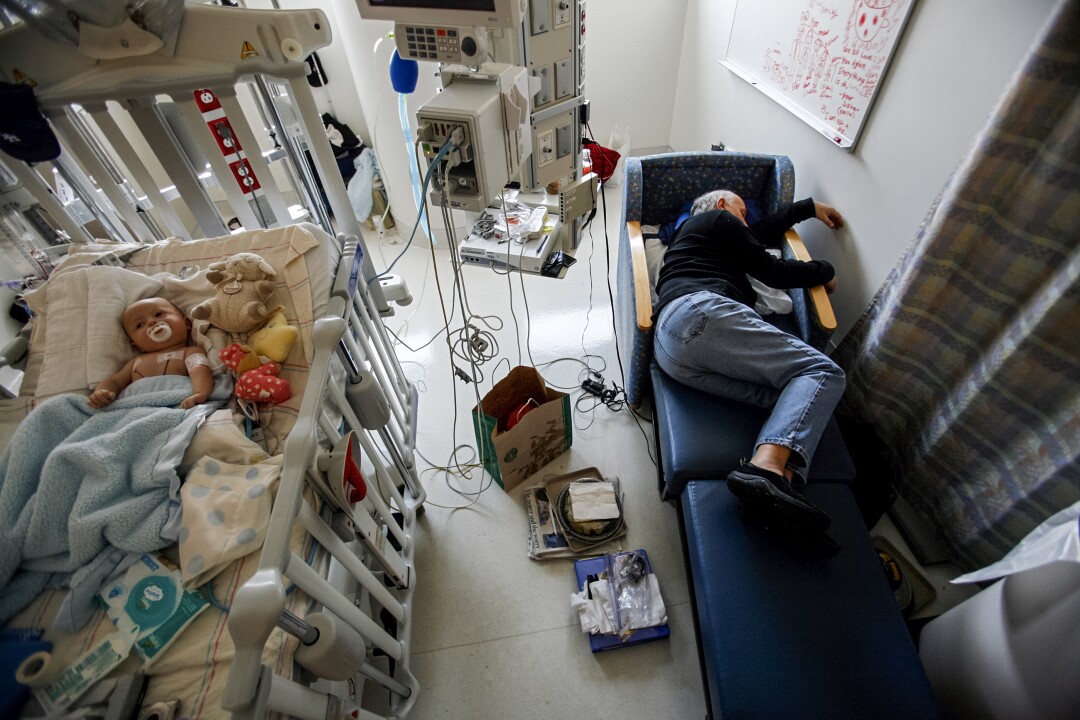
Jeff Catania, 60, has not left his son Dylan Catania’s side since Dylan’s hemispherectomy at the Mattel Children’s Hospital UCLA. Jeff takes a quick nap in the hospital’s Pediatric Intensive Care Unit next to Dylan’s crib a week after the surgery.
(Francine Orr / Los Angeles Times)
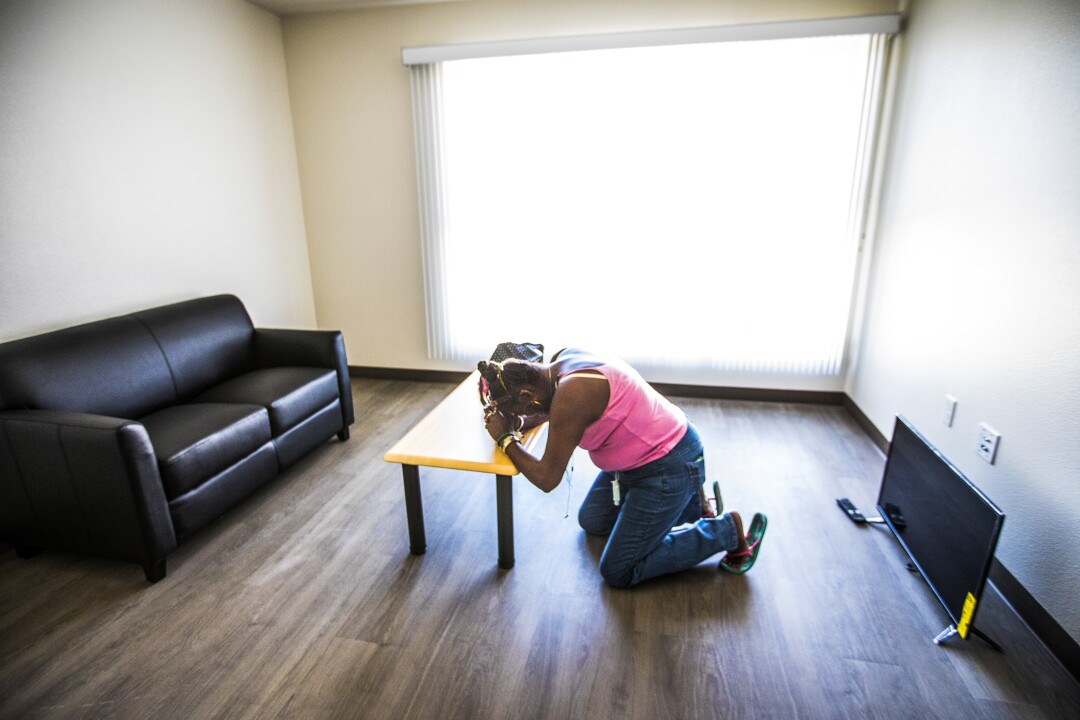
Yvette Grant, known as Big Mama, drops to her knees in prayer after receiving a key to an apartment in 2018, allowing her to move out of a tent on the sidewalk.
(Francine Orr / Los Angeles Times)

Valerie Zeller, center, prepares to get married on March 20, 2021, with help from Heather Yoo, left and Amie Roe, right. Zeller, and her husband-to-be, Henry, are homeless and live in tents in the park. Members of the Wilderness International Church and other church groups are helping the couple with the wedding.
(Francine Orr / Los Angeles Times)
Behind the photograph:
I was struck by the kindness people showed to the wedding couple that day. Most people will not make eye contact with people living outdoors. I saw a pastor’s wife wash Valerie’s hair and put makeup on her.
It was a simple act of kindness I generally do not see on the streets.
Francine Orr
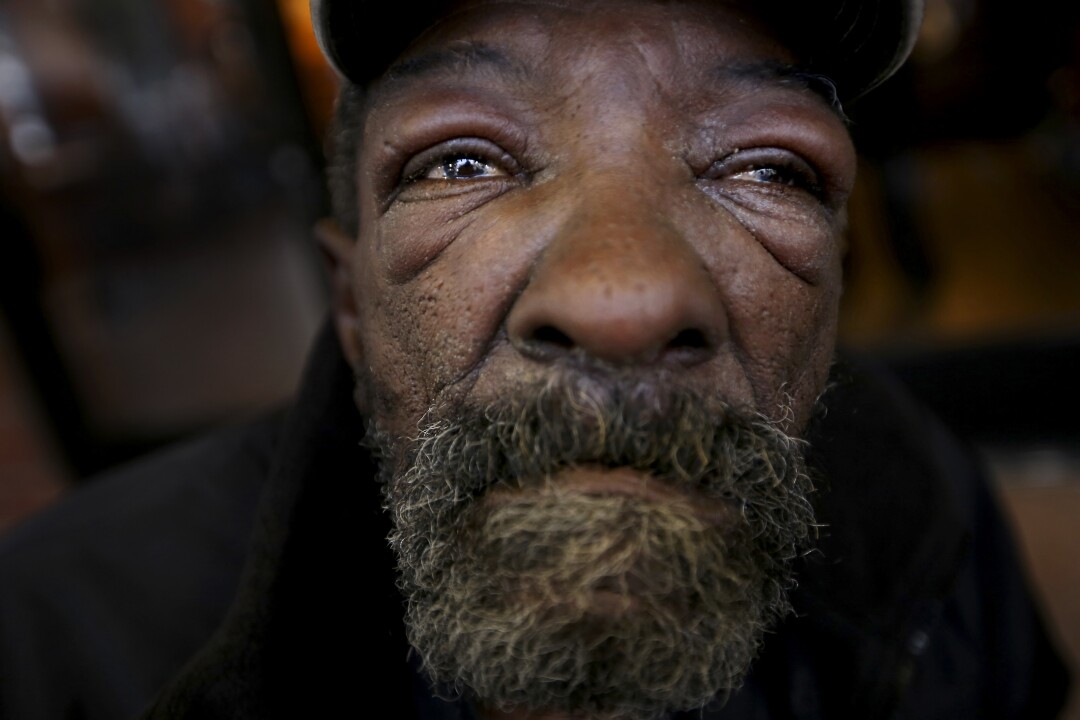
In pain, Eddie Carter, 65, a double amputee who uses a wheelchair, sits outside of Starbucks in Hollywood in 2017. Anthony Ruffin saw that his client Carter’s hands and eyes were badly puffed. The last time he was like that, Ruffin said, it turned out to be a staph infection, and he underwent his second amputation. Ruffin managed to persuade Carter to accept a ride to the hospital.
(Francine Orr / Los Angeles Times)

Rachel Phillips, a homeless woman with mental health issues, sleeps on the sidewalk in Hollywood in 2017. Phillips has called this stretch of sidewalk, outside Hollywood United Methodist Church, home for the past 15 to 20 years. Anthony Ruffin worked to get her help, and she was later hospitalized.
(Francine Orr / Los Angeles Times)
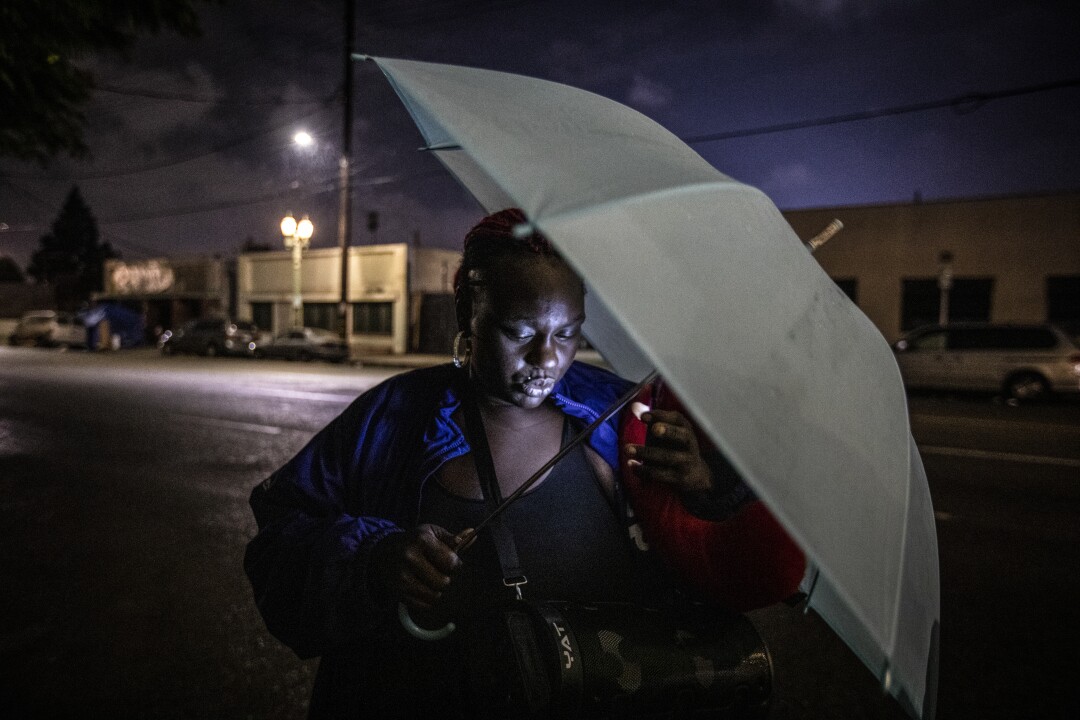
Niecy pulls out her phone as she stands on Broadway Place. The light from her phone illuminates her face. Rain starts falling. Niecy opens her umbrella, and she and Bam disappear into the night.
(Francine Orr / Los Angeles Times)

“Thick and Juicy,” otherwise known as T.J., stands on the corner of 6th Street and San Julian in the skid row neighborhood of Los Angeles in 2005. She says she works and lives in these portable toilets. “I run this corner,” she said. The portable toilets were later removed.
(Francine Orr / Los Angeles Times)
Behind the photograph:
I had the privilege of working with Los Angeles Times columnist Steve Lopez on a series of stories in 2005 focused on skid row when we came across two prostitutes working out of the portable toilets at 6th and San Julian streets near the police station.
Lopez and I thought the situation was bad then. Millions of dollars were poured into housing the homeless following the report. Promises were made.
Things improved briefly. The numbers on skid row grew fewer following the influx of funding, but then the recession hit in 2008. The number of people living on the street in skid row grew, and now it continues to rise amid the global pandemic.
The reporting captured the attention of Los Angeles Times readers and city officials
Francine Orr

The Lord’s Resistance Army in northern Uganda abducts children, turning them into soldiers, porters, and sex slaves. For safety, children flock into town centers at dusk for safety. The children are known as “night commuters,” who sleep side by side in the bus station in Gulu, Uganda.
(Francine Orr / Los Angeles Times)

Peeking through holes in the Cecilia Wahu’s tin house, Wairimu Wahu, left, and Margaret Wambui, center, are seen sitting on the dirt path in the small slum called Deep Sea. Children laugh as they run barefoot over the paths. Sounds of children laughing, crying, the smell of human excrement, and cooking fill the air. Some 1,500 souls are crammed here into a 4-acre plot. Of Nairobi’s 3 million people, 60% are crammed into about 100 such slums on 5% of the land.
(Francine Orr / Los Angeles Times)

A “night commuter” bundled in a blanket outside Saint Mary Lacor Hospital, about four kilometers from the town of Gulu in northern Uganda. This week the hospital counted an average of 5,500 women and children night commuters seeking shelter at the hospital. Because of the security situation, the numbers can be much higher. This week there was an LRA rebel attack near the hospital about midnight, and people were reported to have been abducted.
(Francine Orr / Los Angeles Times)
Behind the photograph:
As dusk falls across northern Uganda, scores of children begin their nightly trek into the centers of remote provincial towns. They sleep in doorways, on verandas, and at drafty bus stations, hospitals, and schools. They are known as “night commuters,” and they make the hike from their desolate rural homes because they are afraid.
For almost two decades, a notorious rebel group that had called itself the Lord’s Resistance Army, or LRA, has been terrorizing villagers. It kidnaps adults to haul heavy loads over long distances. But it also kidnapped children, some as young as 8. The LRA forces the boys to become soldiers; the girls become sex slaves.
This young boy was a “night commuter.” He was bundled in a blanket as he walked outside Saint Mary Lacor Hospital, about four kilometers from Gulu town, northern Uganda, April 1, 2005. That week the hospital counted an average of 5,500 night commuters, children and women seeking shelter at the hospital. Because of the security situation, the numbers can be much higher.
I tried sleeping inside the hospital guest quarters and heard an LRA rebel attack one night near the hospital around midnight. The next morning I learned several people had been abducted nearby.
Francine Orr

Ikite Ledamo, 3, cuddles up to Birtukan Ledamo, top, as Birtukan bakes bread inside their round mud hut in the Finchawa village about 15 minutes outside of Awassa, Ethiopia. The kitchen area is just feet from where the cows live. In the Sidama language, the name Ikite translates to “enough.” Sidama language is the language spoken by the Sidama people, 90% of whom do not speak Amharic, the national language, or any other language beyond Sidama.
(Francine Orr / Los Angeles Times)
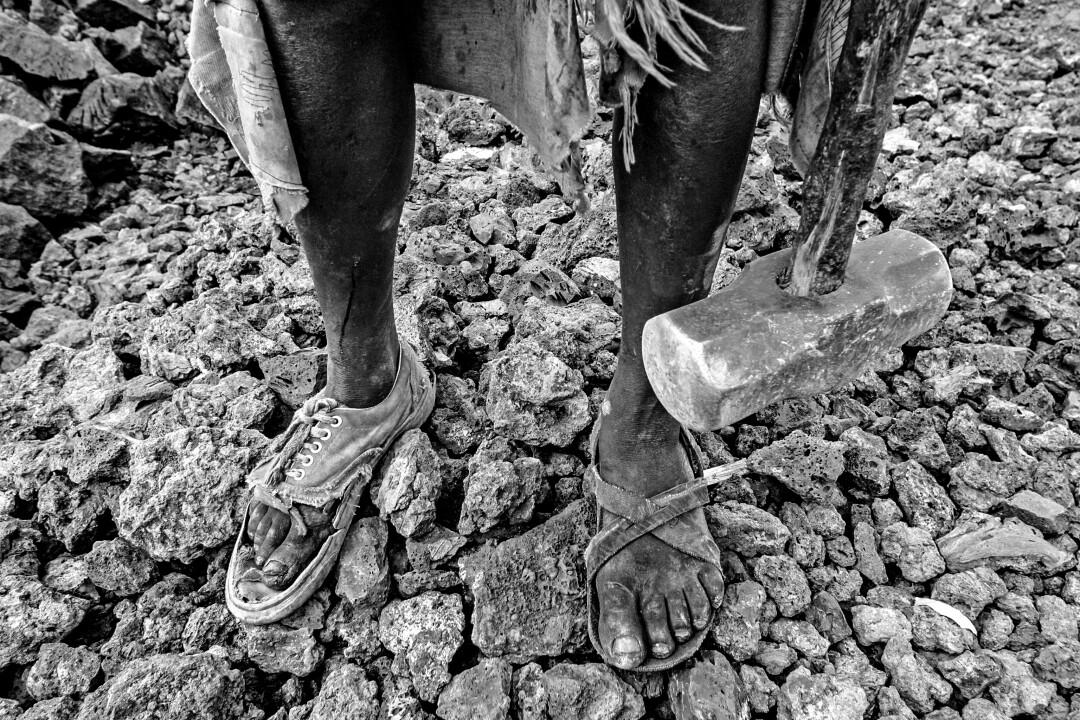
Wearing torn clothing and unmatched shoes, Byabuze Habyarimana, 45, spends his days breaking apart pieces of lava to build fences or roads, in Goma, Democratic Republic of Congo. He earns less than one dollar a day. Mount Nyiragongo is located roughly 6 miles north of the town of Goma, near the border with Rwanda. The volcano erupted on Jan. 17, 2002, devastating Goma.
(Francine Orr / Los Angeles Times)
Source link
[ad_2]
source https://earn8online.com/index.php/235388/celebrating-women-photographers-francine-orr/


No comments:
Post a Comment